Neutron EDM
It turns out that the “roundness” of the neutron’s electric charge distribution (measured by the Electric Dipole Moment, EDM) is connected at a deep level to a rather fundamental question – “Why is there any matter in the Universe?” Detecting non-zero nEDM would mean a huge breakthrough in the search for Beyond the Standard Model Physics.
Matter and anti-matter were created in equal amounts during the Big Bang. Almost all of it (all but about half a part per billion) was annihilated in subsequent matter/anti-matter collisions. Clearly (and thankfully) a small excess of matter survived to form our Universe. Theories attempting to explain this almost invariably predict that the neutron is not quite perfectly round.
Our group plays a major role in an extremely challenging experimental program to develop a new technique to search for the neutron electric dipole moment. This is a most complicated experiment in modern fundamental neutron physics. The idea of the experiment was published in 1994 by Bob Golub and Steve Lamoreaux. The design of experiment took off only a decade later , in 2004, first at Los Alamos National Lab. With commissioning of Spallation Neutron Source (SNS), it was decided that experiment will take place at Fundamental Physics cold neutron beam at SNS and was called nEDM@SNS Collaboration https://www.phy.ornl.gov/nedm/. The new experimental approach of nEDM@SNS offers an improvement in sensitivity of up to two orders of magnitude ( J. Inst. 14 P11017 (2019) ). The key to success of the new technique is a precise manipulation of the spins of polarized neutrons and He-3 atoms, diluted in the superfluid He-4. Detecting non-zero nEDM would mean a huge breakthrough in the search for the beyond the Standard Model physics.
Our team activity is focused on building a cryogenic test-bed apparatus (Systematic and Operational Study apparatus, SOS), where we are going to explore different Nuclear Magnetic Resonance (NMR) approaches to spin gymnastic. The test bed has all components of the nEDM@SNS apparatus but high electric field. Currently, the apparatus is located at Science building, Duke university (SOS@TUNL). Later it will be moved to the source of ultracold neutrons at PULSTAR rector (SOS@PULSTAR, NCSU). We also have a cryogenic lab at Riddick for assembly and stand along tests of components and prototypes.

SOS@TUNL apparatus
The main SOS components are: cryogenic, He-3 polarization using laser (MEOP), SQUIDs, NMR electronic, measurement cell & scintillation light collection with DAQ, spin tracking simulation package, cryogenic, superconducting coils and magnetic shields, external field compensation coil and shields, neutron guide and UCN transport simulation. At present most of components are designed and fabricated except for the superconducting magnetic package, which is our fabrication focus at present. We have to develop many unique parts using unusual for cryogenic materials, for instance, a plastic bellow invented by our former grad student Austin Reid (Phys. Rev. E95 013002 (2017).).
In the video below our another former grad student and postdoc Adam Dipert tells more about our experiment and also about the diversity of skills one can to learn when working on our experiment.
In 2024 we plan to complete assembly and tests of all components and to start our first set of experiments with polarized He-3.
In parallel we are working on assembly and commissioning of UCN source at PULSTAR reactor on NCSU campus, where SOS apparatus will be moved after completing He-3 studies.
Our group is also involved in Ultra-Cold Neutron (UCN) storage experiments at LANL UCN source. This experiments helps to characterize UCN friendliness of the measurement cells.
Our team
P. R. Huffman, R. Golub, E. Korobkina, I. Berkutov, T. Rao , C. Hickman, C. Teander, M. Morano
Bob Golub is co-founder of nEDM@SNS experiment and principal scientist.
Ekaterina Korobkina and Paul Huffman are subsystem managers for nEDM@SNS (SOS apparatus and Assembly and commissioning subsystems). In addition, Paul Huffman is Technical Coordinator for the entire project.
Bob Golub and Paul Huffman co-chair the internal technical committee for the project which meets weekly.
Igor Berkutov is chief cryogenic person for SOS apparatus
Tom Rao is in charge of MEOP HE-3 laser polarization system, SQUIDs and Slow Controls.
Our current grad students:
Matt Morano developed very precise and reproducible digital power source for coils, developed system for active magnetic field cancelation, wrote a spin tracking software, which will help us to analyze spin data and theoretically predict how to minimize systematic errors, integrated NMR electronic components in one system ready for operation; developed a code to obtain a complicated NMR pulse for precise spin manipulation of two different spins . He is going to graduate in 2023 and stay with us as a postdoc.
Clark Hickman is working on development of superconducting components for magnetic coils and is actively involved in measurements and data analyze for LANL UCN storage.
Cole Teander has designed cryogenic neutron window for nEDM@SNS and now he is working on UCN source at PULSTAR reactor He is also actively involved in measurements and UCN transport simulations for LANL UCN storage.
We are working in close collaboration with Caltech (magnetic coils/shields, spin dressing technique), University of Kentucky (magnetic coils/shields), Montclair University (measurement cell), ORNL (scintillation light collection with DAQ), LANL (SQUIDs, UCN storage), UNAM (MEOP coil)
Our posters
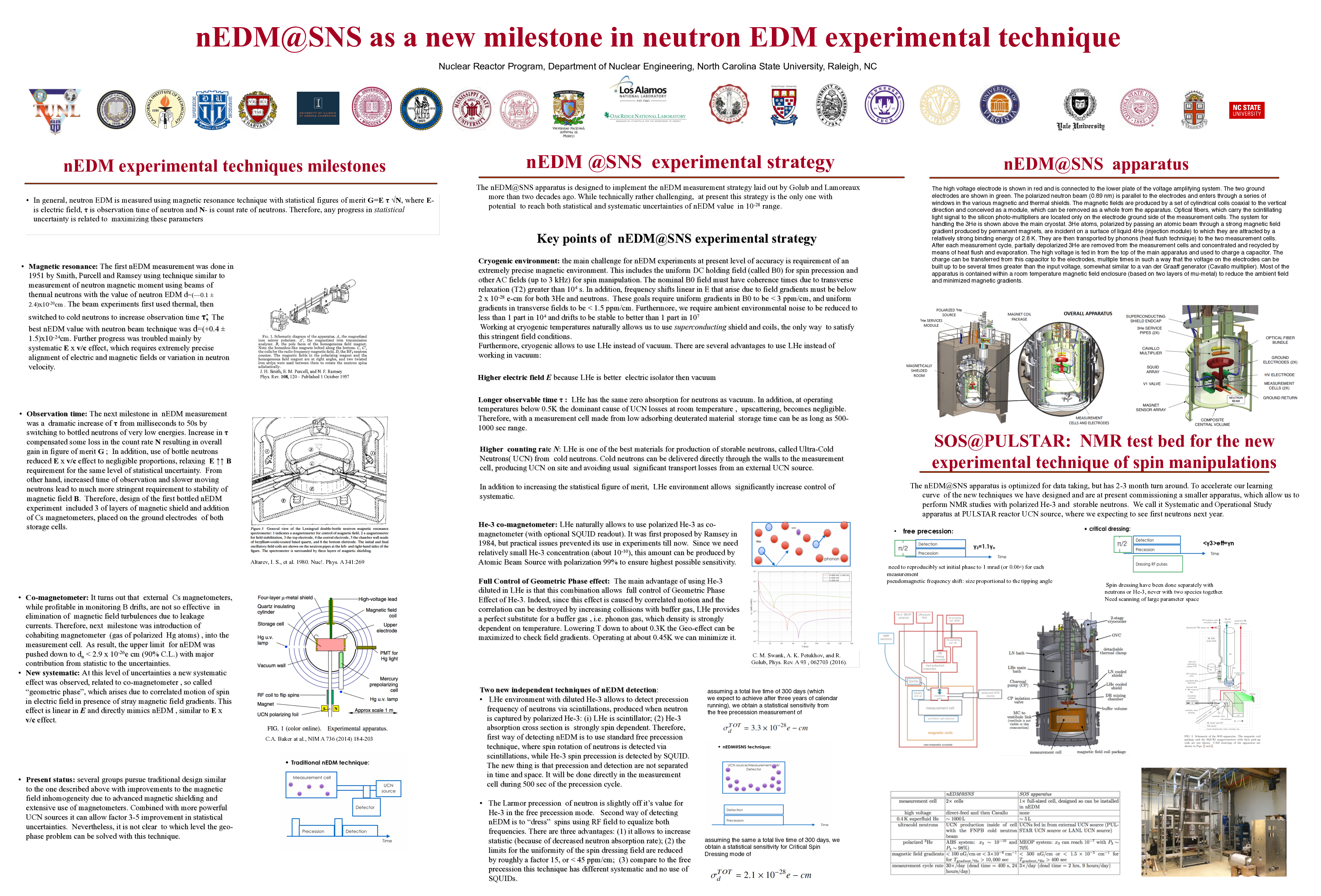 – What makes nEDM@SNS experiment very special and why we need Systematic and Operational Study testbed.
– What makes nEDM@SNS experiment very special and why we need Systematic and Operational Study testbed.
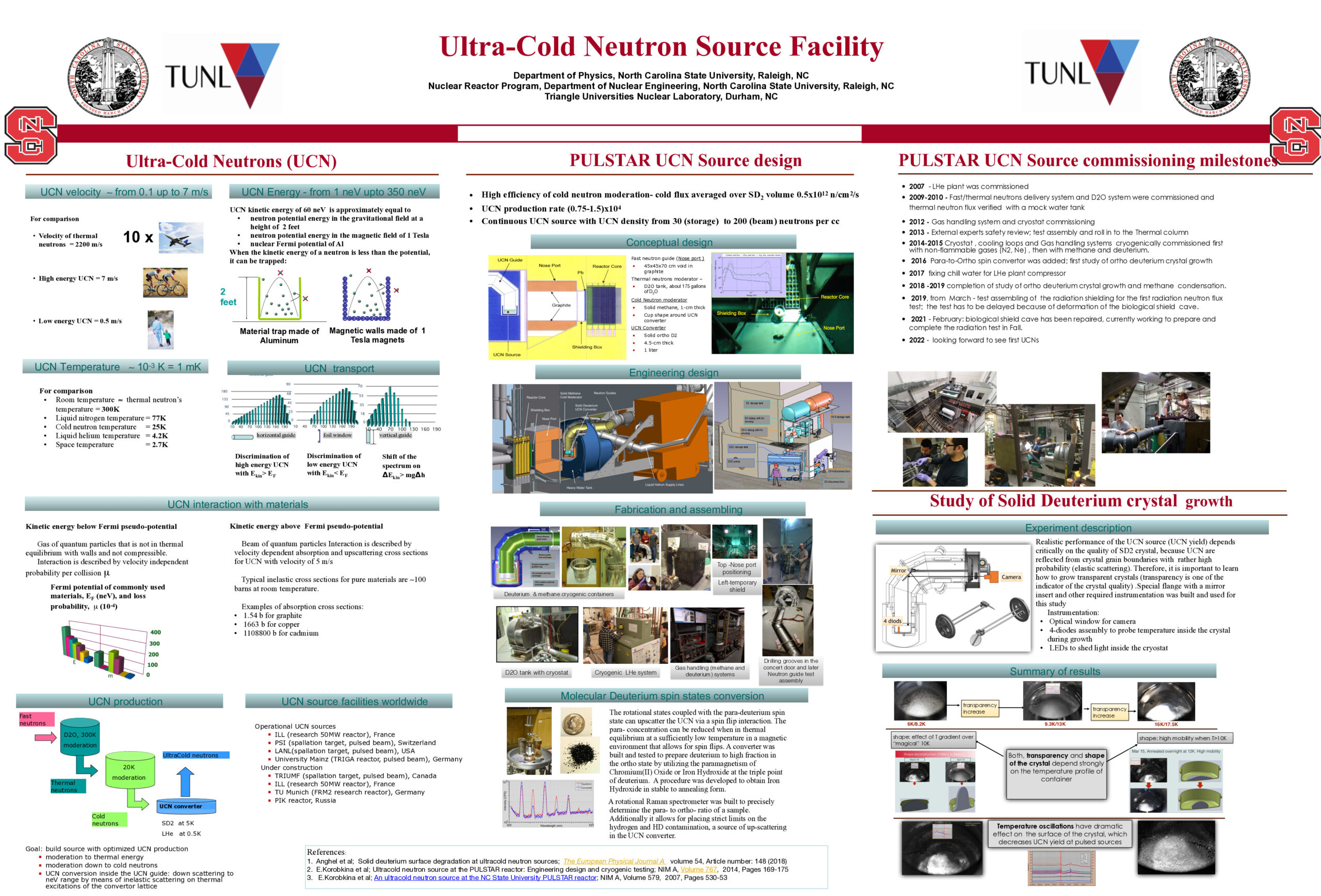 – about UCN source at PULSTAR reactor
– about UCN source at PULSTAR reactor
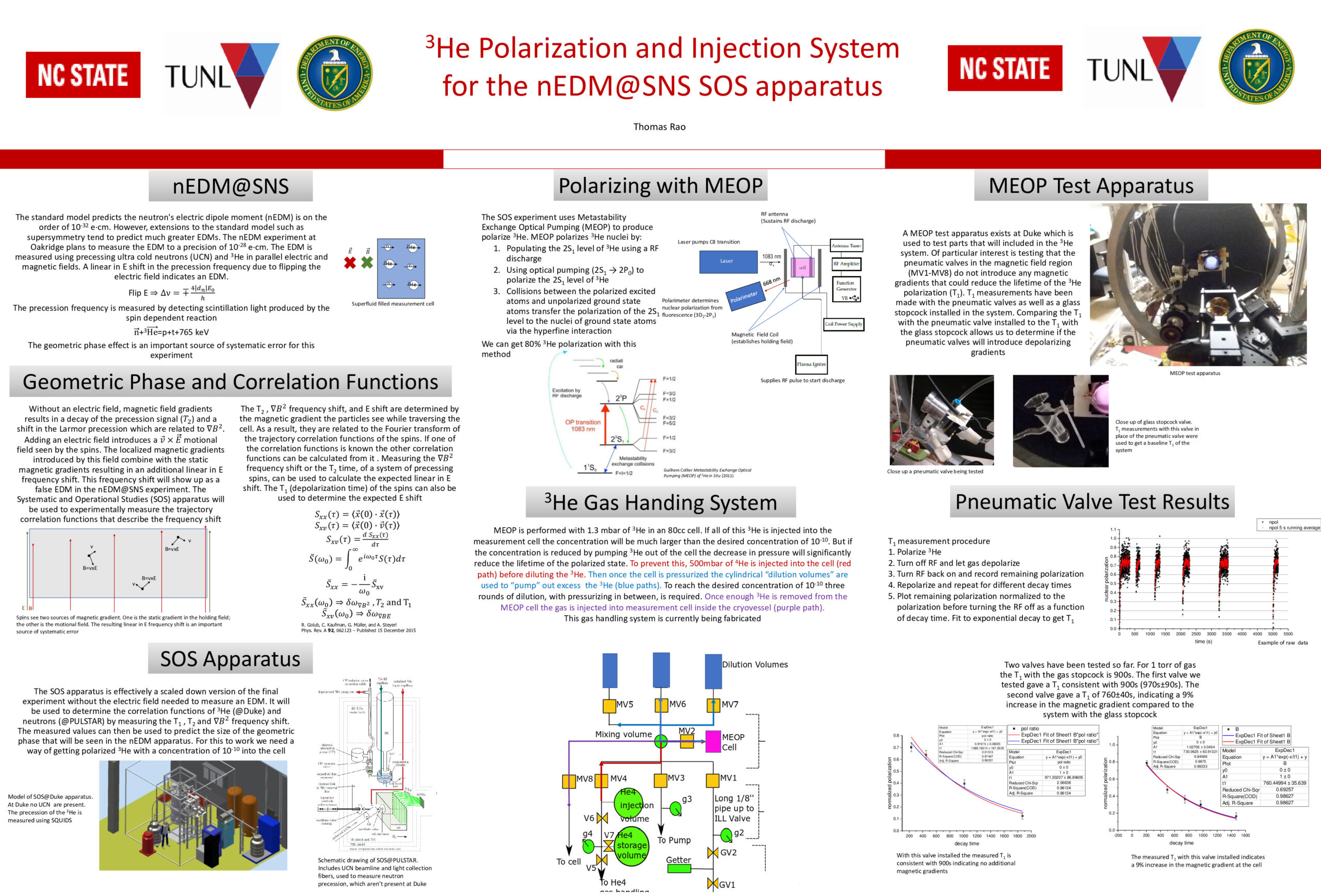 – how we polarize He-3 nuclei using MEtastable OPtical exchange (MEOP)
– how we polarize He-3 nuclei using MEtastable OPtical exchange (MEOP)
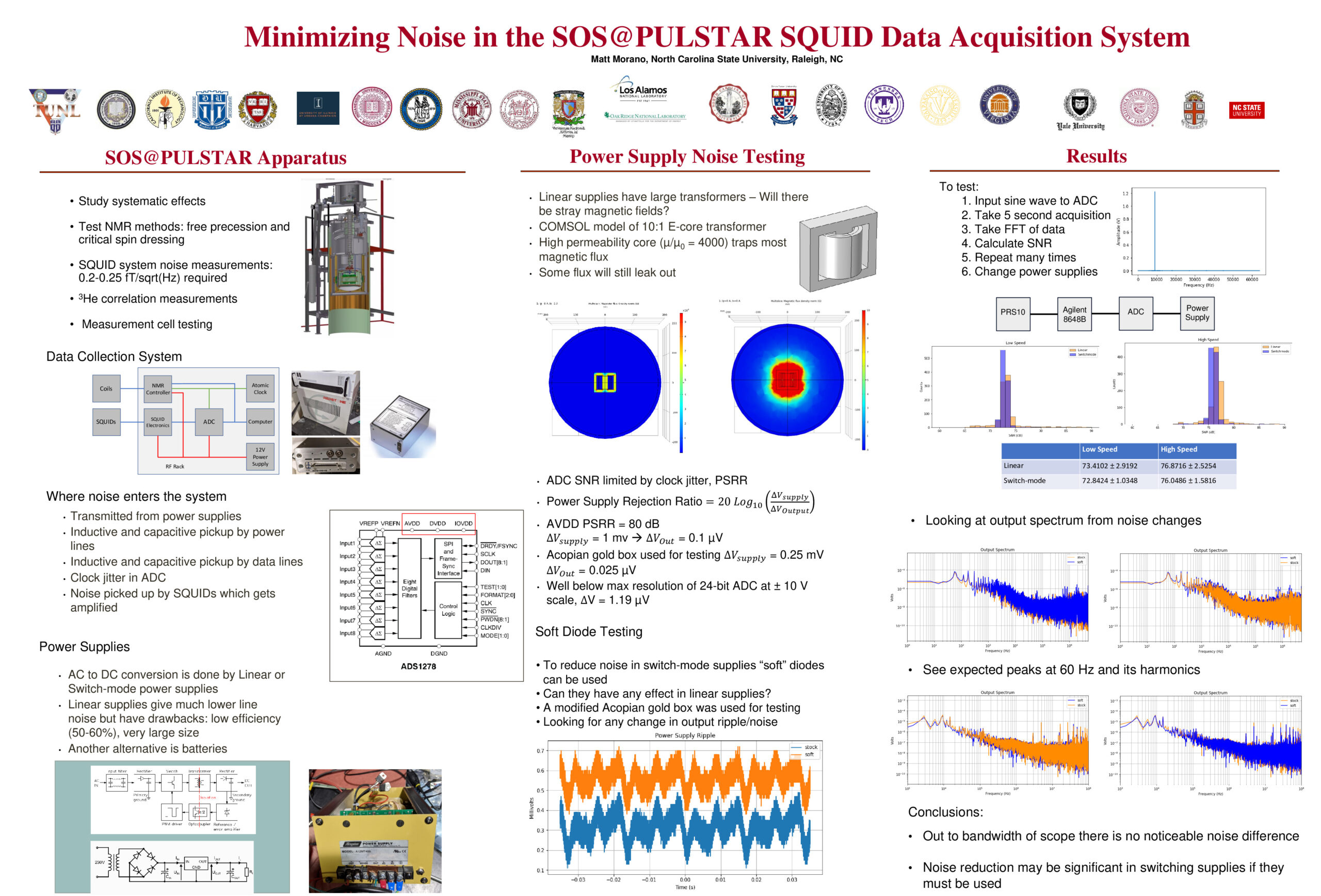 – about SQUIDs
– about SQUIDs
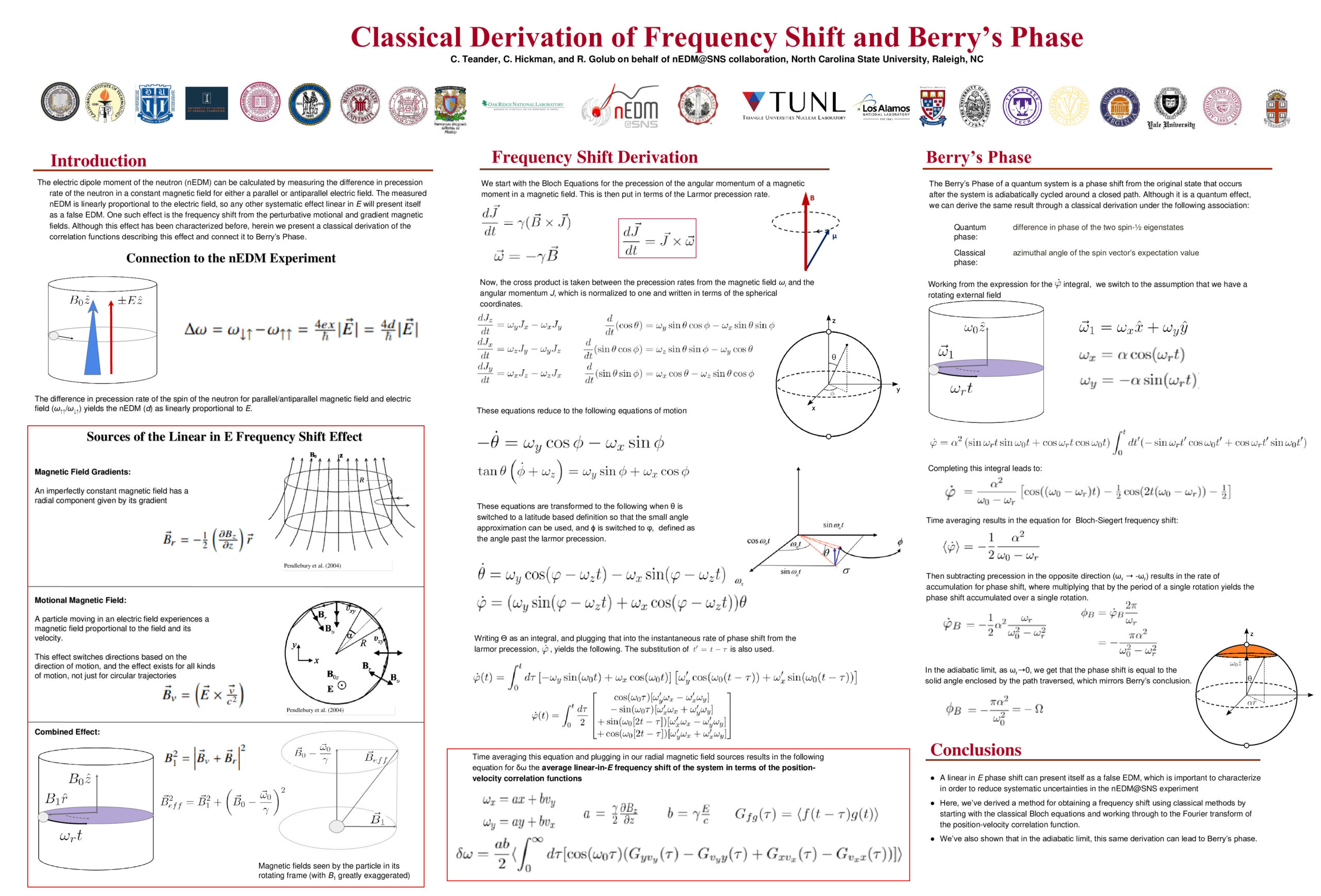 – Berry phase and frequency shift
– Berry phase and frequency shift
Our publications
- “Growing solid deuterium for UCN production”. Journal of Neutron Research, Korobkina, E., Berkutov, I., Golub, R., Huffman, P., Hickman, C., Leung, K., … & Young, A. R. (2022). , (Preprint), 1-13
- “A New Cryogenic Apparatus to Search for the Neutron Electric Dipole Moment,” M.W. Ahmed et al., J. Inst. 14 P11017 (2019)
- “The neutron electric dipole moment experiment at the Spallation Neutron Source,” K.K.H Leung et al., EPJ Web of Conferences 219, 02005 (2019)
- “Solid deuterium surface degradation at ultracold neutron sources.” A. Anghel, T. L. Bailey, G. Bison, B. Blau, L. J. Broussard, S. M. Clayton, C. Cude‐Woods, M. Daum, A. Hawari, N.Hild, P. Huffman, T. M. Ito, K. Kirch, E. Korobkina, B. Lauss, K. Leung, E.M. Lutz, M. Makela, G.Medlin, C. L.Morris, R. W.Pattie, D. Ries, A. Saunders, P. Schmidt‐Wellenburg, V. Talanov, A. R. Young, B. Wehring, C. White, M. Wohlmuther, and G.Zsigmond. European Physical Journal A54 148 (2018) DOI: 10.1140/epja/i2018‐12594‐2
- “Geometry and design of origami bellows with tunable response,” A. Reid, F. Lechenault, S. Rica and M. Adda-Bedia, Phys. Rev. E95 013002 (2017).
- “Random walks with thermalizing collisions in bounded regions: Physical applications valid from the ballistic to diffusive regimes,” C.M. Swank, A. K. Petukhov and R. Golub, Phys. Rev. A93 062703 (2016).
- “Frequency shifts and relaxation rates for spin-1/2 particles moving in electromagnetic fields,” G. Pignol, M. Guigue, A. Petukhov, R. Golub, Phys. Rev. A92 053407 (2015).
- “Geometric phases in electric dipole searches with trapped spin-1/2 particles in general fields and measurement cells of arbitrary shape with smooth or rough walls,” R. Golub, C. Kaufman, G. Muller, A. Steyerl, Phys. Rev. A92 062123 (2015).
- “Fundamental neutron physics beamline at the spallation neutron source at ORNL,” N. Fomin, G. Greene, R. Allen, V. Cianciolo, C. Crawford, T. Ito, P. Huffman, E. Iverson, R. Mahurin, W. Snow, Nucl. Inst. Meth. A773 45 (2015).
- “Calculation of geometric phases in electric dipole searches with trapped spin-1/2 particles based on direct solution of the Schrodinger equation,” A. Steyerl, C. Kaufman, G. Mueller, S.S. Malik, A.M. Desai, R. Golub, Phys. Rev. A89 052129 (2014).
- “Ultracold neutron source at the PULSTAR reactor: Engineering design and cryogenic testing,” E. Korobkina, G. Medlin, B. Wehring, A.I. Hawari, P.R. Huffman, A.R. Young, B. Beaumont, G. Palmquist, Nucl. Inst. Meth. A767 169 (2014)
- “Experimental Searches for the Neutron Electric Dipole Moment,” S.K. Lamoreaux and R. Golub, J. Phys. G36 104002 (2009).
- “Relaxation of spin-polarized 3He in mixtures of 3He and 4He at about 330 mK,” Q. Ye, H. Gao, W. Zheng, D. Dutta, F. Dubose, R. Golub, P. Huffman, E. Korobkina, C. Swank, Phys. Rev. A80 023403 (2009)
- “Relaxation of spin polarized 3He in mixtures of 3He and 4He below the 4He lambda point,” Q. Ye, D. Dutta, H. Gao, K. Kramer, X. Qian, X. Zong, L. Hannelius, R. McKeown, B. Heyburn, S. Singer, R. Golub, E. Korobkina, Phys. Rev. A77 053408 (2008)
- “Electric dipole moment searches: Effect of linear electric field frequency shifts induced in confined gases,” A.L. Barabanov, R. Golub and S.K. Lamoreaux, Phys. Rev. A74 052115 (2006)
- “Evaporative Isotopic Purification of Superfluid Helium-4,” M.E. Hayden, S.K. Lamoreaux and R. Golub, Am. Inst. Phys. Conf. Proc. 850 147 (2006)
- “Characterization of Scintillation Light produced in Superfluid Helium-4,” G. Archibald, J. Boissevain, R. Golub, C.R. Gould, M.E. Hayden, E. Korobkina, W.S. Wilburn, J. Zou, Am. Inst. Phys. Conf. Proc. 850 143 (2006)
- Detailed discussion of a linear electric field frequency shift induced in confined gases by a magnetic field gradient: Implications for neutron electric-dipole-moment experiments, SK Lamoreaux, R Golub, Physical Review A 71 (3), 032104 (2005)
Books by Prof. Bob Golub
- “Ultra-cold neutrons”, R. Golub, D. Richardson, S.K. Lamoreaux, CRC Press – 1991
- “The historical and physical foundations of Quantum mechanics”, R. Golub, S.K. Lamoreaux, Oxford University press, 2023
Original proposal for experimental technique of nEDM@SNS experiment
- Neutron electric-dipole moment, ultracold neutrons and polarized 3He; R Golub, SK Lamoreaux – Physics Reports, 1994. https://www.sciencedirect.com/science/article/pii/0370157394900841

